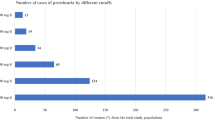Abstract
Objective
To assess whether a spot urinary albumin:creatinine ratio (ACR) measured before 20 weeks of gestation can predict subsequent development of preeclampsia.
Methods
The ACR was determined from midstream urine sample taken between 17 and 20 weeks of gestation. Urine albumin was measured by immunoturbidimetric method using commercially available kit (Beckman Coulter) through Beckman AU 480 fully automated biochemistry analyzer. Urine creatinine was measured by modified kinetic Jaffe reaction without deproteinization.
Participants were then followed until delivery. Primary outcome measure was preeclampsia, secondary outcome measures were gestational hypertension, gestational diabetes mellitus, IUGR, and normal range estimate of urinary albumin-to-creatinine ratio was established.
Result
The median spot urinary albumin-to-creatinine ratio measured between 17 and 20 weeks of gestation was 5.2 mg/g of creatinine (2.5–9.6). Women who subsequently developed preeclampsia had higher spot urinary albumin-to-creatinine ratio (median 30.795 [9.7–92.8]) in comparison with women who developed gestational hypertension (median 5.2 [0.7–7.2]) and unaffected women (median 5.2 [2.5–9.6]). The urinary albumin-to-creatinine ratio of the mother who developed IUGR was significantly higher. By ROC analysis, the optimum ACR to predict preeclampsia was 9.85 mg/g of creatinine. The relative risk of developing preeclampsia in women with urinary albumin-to-creatinine ratio more than 9.85 mg/g of creatinine was higher than in the women who had urinary albumin-to-creatinine ratio less than 9.85 mg/g of creatinine.
Conclusion
A spot urinary albumin-to-creatinine ratio of more than 9.8 mg/g of creatinine can predict the development of preeclampsia in later pregnancy with the sensitivity and specificity of 67 and 76%, respectively. However, additional studies and cost–benefit analysis are required to confirm these finding before recommending this test for screening purposes.


Similar content being viewed by others
References
Townsend R, O’Brien P, Khalil A. Current best practice in the management of hypertensive disorders in pregnancy. Integr Blood Press Control. 2016;9:79–94.
Poon LC, Nicolaides KH. Early prediction of preeclampsia. Obstet Gynecol Int. 2014;2014:297397.
Villa PM, Kajantie E, Räikkönen K, et al. Aspirin in the prevention of pre-eclampsia in high-risk women. BJOG. 2013;120(6):773.
Thangaratinam S, Langenveld J, Mol BW, et al. Prediction and primary prevention of pre-eclampsia. Best Pract Res Clin Obstet Gynaecol. 2011;25(4):419–33.
Torrado J, Farro I, Zócalo Y, et al. Preeclampsia is associated with increased central aortic pressure, elastic arteries stiffness and wave reflections, and resting and recruitable endothelial dysfunction. Int J Hypertens. 2015;2015:720683.
Ohkuchi A, Hirashima C, Takahashi K, et al. Prediction and prevention of hypertensive disorders of pregnancy. Hypertens Res. 2016. doi:10.1038/hr.2016.107.
Fagerstrom P, Sallsten G, Akerstrom M, et al. Urinary albumin excretion in healthy adults: a cross sectional study of 24-hour versus timed overnight samples and impact of GFR and other personal characteristics. BMC Nephrol. 2015;16:8.
Huang Q, Gao Y, Yu Y, et al. Urinary spot albumin:creatinine ratio for documenting proteinuria in women with preeclampsia. Rev Obstet Gynecol. 2012;5(1):9–15.
Tranquilli AL, Dekker G, Magee L, et al. The classification, diagnosis and management of the hypertensive disorders of pregnancy: a revised statement from the ISSHP. Pregnancy Hypertens. 2014;4(2):97–104.
Magee LA, Pels A, Helewa M, et al. SOGC hypertension guideline committee. Diagnosis, evaluation, and management of the hypertensive disorders of pregnancy: executive summary. J Obstet Gynaecol Can. 2014;36(7):575–6.
Demirci O, Kumru P, Arınkan A, et al. Spot protein/creatinine ratio in preeclampsia as an alternative for 24-hour urine protein. Balkan Med J. 2015;32(1):51–5.
Morris RK, Riley RD, Doug M, Deeks JJ, Kilby MD. Diagnostic accuracy of spot urinary protein and albumin to creatinine ratios for detection of significant proteinuria or adverse pregnancy outcome in patients with suspected pre-eclampsia: systematic review and meta-analysis. BMJ. 2012;345:e4342.
Baweja S, Kent A, Masterson R, et al. Prediction of pre-eclampsia in early pregnancy by estimating the spot urinary albumin: creatinine ratio using high-performance liquid chromatography. BJOG. 2011;118(9):1126–32.
Singh H, Samal S, Mahapatro A, et al. Comparison of obstetric outcome in pregnant women with and without microalbuminuria. J Nat Sci Biol Med. 2015;6(1):120–4.
Author information
Authors and Affiliations
Corresponding author
Ethics declarations
Conflict of interest
Dr. Nupur gupta, Dr. Taru Gupta and Dr. Deepti Asthana declare that they have no conflict of interest.
Ethical Standard
All procedures followed were in accordance with the ethical standards of the responsible committee on human experimentation (institutional and national) and with the Helsinki Declaration of 1975, as revised in 2008.
Informed Consent
Informed consent was obtained from all patients for being included in the study.
Animal Rights
This article does not contain any studies with animal subjects.
Additional information
Dr. Nupur Gupta is an Assistant Professor at ESI PGIMSR New Delhi, Dr. Taru Gupta is a Professor at ESI PGIMSR New Delhi, Dr. Deepti Asthana is a Senior Resident at ESI PGIMSR New Delhi.
Rights and permissions
About this article
Cite this article
Gupta, N., Gupta, T. & Asthana, D. Prediction of Preeclampsia in Early Pregnancy by Estimating the Spot Urinary Albumin/Creatinine Ratio. J Obstet Gynecol India 67, 258–262 (2017). https://doi.org/10.1007/s13224-016-0958-z
Received:
Accepted:
Published:
Issue Date:
DOI: https://doi.org/10.1007/s13224-016-0958-z




